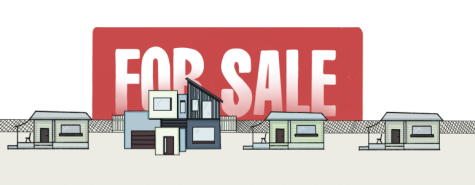Perspective: Stability moves out
Locals in East Palo Alto face the consequences of scarce low-income housing
“As the years went by I saw houses come down only to be built back up newer and modern looking,” said Martha Estrada, a Junior at Palo Alto High School. “I saw new faces. I saw more people of different races moving in — a lot wealthier too, because of the houses they were moving into.”
When Estrada was 9 years old, she realized her anger for the system that allowed this. Not only was her family forced to move frequently from room to room — from the lack of funds to afford a whole house. Not only having to live with multiple families at once and dealing with the chaos and stress. Not only experiencing eviction from a household and watching as someone rented it out for a larger sum of money after its renovation.
“It made me jealous because all these wealthy people moving into their nice houses made me realize…how badly I wanted to live in a nice house,” Estrada said.
Enduring these hardships show the disadvantage low-income families face.
Gentrification is the process of displacing a neighborhood population, while negatively impacting the overall culture. Not only does this hurt the way things are run, but it strips away the city’s long-formed identity.
Undergoing this influence in the past, East Palo Alto locals are facing life-changing circumstances.
What if your community shifted so drastically you don’t feel welcome anymore? What would happen if your community’s inner workings are so challenged by newcomers that its distinctiveness has been totally revoked? Would it make you question your ability to continue living there?
“[Gentrification] pushes people out, and it excludes other people by virtue of their economic situation,” said Ruben Abrica, mayor of East Palo Alto and founder of the EPA Council responsible for carrying out and developing the city’s policy.
According to Tech at Meta, 58,000 new employees of Meta have moved to the Bay Area since 2021. As the demand for workers rises, what’s stopping EPA from becoming fully gentrified?
The answer: Bay Areas low-income housing.
“It’s driven by the fact that there is not enough affordable housing,” Abrica said.
A great alternative is East Palo Alto — a safe haven for low-income households who want more opportunities for themselves and their families.
Estrada said: “I used to go around EPA and see old beat up houses, but it still felt like home because that’s what I was used to and seeing the people who looked like me gave me a very welcoming feeling every time I walked around the city.”
As many developers gear up for the chance to restore old houses and sell them for more than allowed by county renters laws to younger generations, it undoubtedly establishes the vicious cycle of gentrification.
Companies maintaining low numbers of outside hires should employ locals fit for the job to ensure not only more diversity into their ranks, but also help stabilize the cost of living in the notoriously pricey Silicon Valley.
“I didn’t know what gentrification meant until I was affected by it,” a Paly student said. “Learning that it not only displaces hard-working people, it’s become systemic oppression—oppression of class, of race and possibly jobs.”
But it’s not just about the employees as the problem stems from landowners.
“About 40% of EPA locals do not own their property,” Abrica said.
The Just Cause Eviction Law prohibits landlords from evicting tenants without leases or at the end of a tenants lease term. Unfortunately, this does nothing to stabilize rent, as stated by Good Life Managment.
“It’s sort of cruel. If we’re forced to go somewhere else, we’re forced out of the community in which we grew up in,” said Estrada.

